Walls of the temple
ARCHITECTURAL BEAUTY IN THE WALLS OF MAIN TEMPLE HALL (SISHYA PARAMPARA)
The four main disciples of Adi Sankara are Hasthamalar, Padmapadar, Sureshwaracharya and Totakacharya
| Shishya | Mattham | Veda | Mahavakya |
|---|---|---|---|
| Padmapada | Govardhana Peetam, East | Rig Veda | Prajnanam Brahma |
| Sureshvara | Sringeri Sarada Peetham, South | Yajur Veda | Aham Brahmasmi |
| Hasthamalakacharya | Dwaraka Peetham, West | Sama Veda | Tattvamasi |
| Totakacharya | Jyotirmatha Peetham, North | Atharva Veda | Ayamatma Brahma |
Apart from these four disciples, the wall panels of Sankara Mattham have paintings of their principal disciples, who have immensely contributed by their life and works. A brief knowledge of them will help us appreciate and remember them with gratitude.
Hasthamalakar
Hasthamalakacharya was a disciple of Adi Sankara. He was made the first Jagadguru of the Dwaraka Peetham, the Mattham founded by Adi Sankara in Dwaraka. Hastamalaka founded a matha by name Idayil Matham in Thrissur, Kerala
When Adi Sankara was at Kollur, he accepted invitations by brahmanas to have Bhiksa at their houses. On such an occasion when he visited a village called Sri Bali (now called Shivalli), where every house was said to emit the holy.
smell of Aginihotra smoke, he came across a brahmana, Prabhakara, who was noted for his learning. He had a son who even after Upanayanam did not take to studying the Vedas; instead preferred to sit around doing nothing. Hearing about Adi Sankara’s visit, Prabhakara approached the Acharya (teacher) with a load of fruit and prostrated before him. He also made his son prostrate before him. Prabhakara explained to Adi Sankara about his son.
Then Adi Sankara addressed that young boy and asked him who he was. The boy replied in 12 verses containing the gist of the Advaita philosophy. Thus Adi Sankara was immensely impressed with him and accepted him as his disciple. He was named Haswtyamalaka (one with the amalaka fruit in his hand) since the knowledge of the Self was nature to him like an Amalaka fruit in one’s hand. His text is called Hastamalakiyam and he, as Hastamalar joined Adi Sankara on his journey.


Sureshvaracharya
Mandana Mishra was a student and follower of Adi Sankara and is also known as Sureshvaracharya. He was a follower of the Karma Mimamsa school of philosophy and later, he became a disciple of Adi Sankara.
Mandana Mishra lived in the ancient town of Mahishmati during the time of Adi Sankara. He is known to be a student of mimansa scholar Kumarila Bhatta. Being a follower of the Karma Mimamsa school, he was a ritualist and performed all of the ritualistic duties prescribed by Vedas.
A legendary describes how Mandana Mishra is said to have first met Adi Sankara. It was customary in the time of Adi Sankara and Mandana for learned people to debate the relative merits and demerits of the different systems of Hindu philosophy. Adi Sankara, an exponent of Advaita philosophy sought a debate with Kumarila Bhatta. However, at that time, Kumarila Bhatta was slowly immolating himself as a penance for his sins. After reading some of Adi Sankara’s works and realizing the depth of his knowledge, he directed Sankara to his greatest disciple, Mandana Mishra, who was a Grihastha, to debate the merits of their respective schools of thought.
Mandana was angered to see Sankara, an ascetic, on the death anniversary of his father. Mandana initially hurled insults at Sankara, who calmly replied to every insult with wordplay. The people in Mandana’s house soon realized Sankara’s brilliance and advised Mandana to offer his respect. Finally Mandana agreed to debate with Sankara.
Mandana and Sankara agreed that Mandana’s wife Sarasawani or Ubhaya Bharathi, would be the arbiter for the debate, and that the vanquished would become a disciple of the victor and accept his school of thought. The debate spanned many days and ranged across many different subjects within the Vedas and the arguments of both competitors were compelling and forceful. Sankara finally emerged victorious. After that Sankara also answered the question posed by Sarasawani.
As agreed, Mandana became a disciple of Sankara and assumed the name of Suresvaracharya. He was the first head of Sringeri Mutt, one the four matthams that Sankara established.
Padmapalar
Padmapadacharya, a direct disciple of Adi Sankara, was the first head of Puri Govardhana Mattham. Padmapada, together with Sureshvara, delevoped ideas that led to the founding of the Vivarana school of commentators. According to tradition, Panchapadika was written in response to Adi Sankara’s request for a commentary on his own Brahmasutrabhasya, and once written was destroyed by a jealous uncle. The surviving text is supposed to be what Adi Sankara could recall of the commentary.
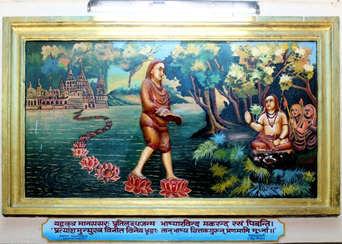
Totakacharya
When Adi Sankara was at Sringeri, he met a boy named Giri. Adi Sankara accepted the boy as his disciple. Giri was hard working and loyal servant of the Guru. Adi Sankara, though he did not appear bright to the other disciples. One day, Giri was washing his Guru’s clothes when Adi Sankara sat down to begin a lesson on Advaita Vedanta. He however did not start the lesson saying that
he was waiting for Giri to come back from his chores and singing lessons. At this, other disciples pointed to a wall and said that it would be the same if Adi Sankara taught to this dumb object as he taught to Giri. Now, Adi Sankara wanted to reward Giri for his loyalty and devotion. Thus he mentally granted Giri the complete knowledge of all the Sastras. The enlightened Giri composed extempore the Totakastakam, a Sanskrit poem in the totaka metre in praise of the Guru Adi Sankara. Thus Giri became Totakacharya.
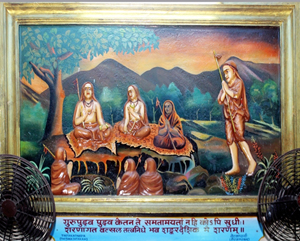
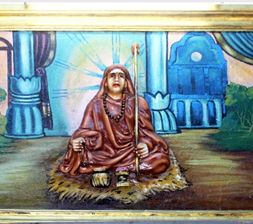
Sarvajna Sricharana
When Adi Sankara was about to ascend the Sarvajna Peetham in Kanchipuram, many scholars from all parts of the country came to challenge His qualification to be recognized as a “sarvajna” (omniscient). Adi Sankara proved his knowledge and was accepted by all scholars. When He was then about to ascend the throne, Sri Sarvajnatma, then a child of seven years who had been silent so far; challenged the Acharya and held Him in scholarly debate for three whole days. One the fourth day, He accepted the replies given by the Acharya and remained silent, after which the Acharya ascended the Sarvajna Peetham.
Adi Sankara was most happy to see such an erudite young child, and asked the child’s father about him. The father replied that since age of six, his son would only intake water, and would speak nothing but the Pranava when spoken to. Adi Sankara then decided to appoint this child as His suitable successor in the Sarvajna Peetham. After obtaining consent of the father, He gave the child sanayasa by the name of Sarvajnatmendra Saraswati and appointed Him as His successor under the guidance of Sri Sureshvara.
This Acharaya retained His vrata of not consuming anything more than water. He composed works on Advaita such as Sankshepa Shariraka.
Vivaranacharya
Vivaranacharya also known as “Prakashatma Yathindra” is the sishya of Ananyana Bhavayathindra. He authored Panchapadika Vivaranam, Sareera Kanyaya Sangrahaha and Shabda Nirnaya. On Padmapada’s Panchapadika, Prakashtman wrote an elabore commentary called “Vivaranam”
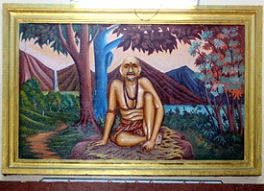
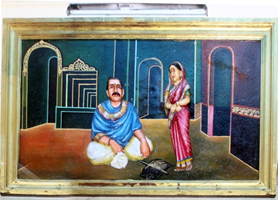
Vachaspathi Mishra
Amalananda Sricharana
Amalananda Sricharana was the sishya of Sukha Prakasha. He authored Vedanta Kalpataru,, Sashtra Darpanam, Pravrithi. Kalpataru is a commentary on Bhamati by Vachaspathi Mishra, which in turn is famous commentary on the Sutra-Bhashya of Adi Sankara.
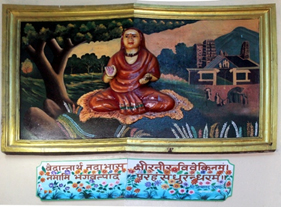

Vidyaranya Swamigal
Appaya Dikshitar
Dikshitar travelled widely, entering into philosophical debates in many centres of learning. He had the rare fortune of being revered and patronized in his life time by the kings of Vellore, Tanjore, Vijayanagara and Venkatagiri.
It appears once, he wanted to test the purity of his mind. Hence he swallowed the juice of the ‘datura’ fruit, which introduces intoxication and told his disciples that they should write down whatever he says, during the stage. In the stage of inebriation generally what is in the subconscious mind would find release and come out into the open. An in his case it was the Atmarpana-Stuti that came out. It is therefore also called Unmatta-Panchasati.
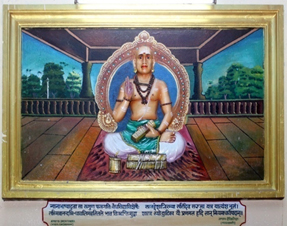
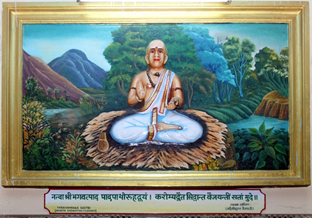
Tryambak Sashtri
Mannargudi Raju Sashtrigal
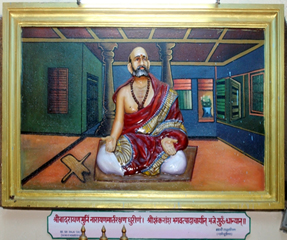
Sastri went to Mannargudi and set up his gurukul and started teaching many students. He taught Veda Sastra, anushtanams and grantha for thousands of students for over sixty years. Scholars, disciples and devotees addressed him with reverence as Mannargudi Periyaval with great respect. People came from Maharashtra, Telugu Desam, Palakadu and from far away places to live and learn from him. Many rich Vidwans and scholars saw his sincere teachings and funded the Gurukul and made food donation to students who lived there. Raju Sastri conducted Somayagam for his father Sri Appa Dikshitar in 1864.
He was the final authority when anyone was in doubt about dharmasashtrams. His authority on the administration of Dharma made many legal luminaries come to him seeking his advice on issues concerning Hindu law. Publishers and authors made it a point to obtain his foreword for their works. He also offered counselling to people of different faiths explaining the common goal of all religions.
In commemoration of the coronation of queen of Victoria in 1887, Raju Sastrigal was selected from the south for the title Mahamahopadhyaya and was invited to Delhi for the award ceremony. Since Sri Sastrigal refused to go to receive the award, the then Governor General directed the then Collector of Thanjavur to confer the title at his residence. Mannargudi Raju Sastrigal was the first from the south to receive this prestigious title. After this title, gifts and felicitations were sent to him from the Thanjavur Collector. Learned scholars came from far away places to meet him every day. Raju Sastrigal formed the “Kumbakonam Advaita Sabha” for propagating the tenets of the Advaita faith.
Thyagaraja Vijayam in Sanskrit written by Mahamahopadyaya Yegnaswami Sastrigal, grandson of Sri Raju Sastrigal, is an elaborate history of Sri Mannargudi Raju Sastrigal. The book describes Sri Mannargudi Raju Sastrigal’s life, scholarship in Veda Sastras, his faith in daily rituals, his love for his students, his compositions and greatness of some of his popular disciples.
Both Painganadu Ganapathy Sastri and Paruthiyur Sri Krishna Sastri had written wonderful slokas in praise of Guru Raju Sastrigal. One of his main disciples, late Mahamahopadhyaya Painganadu Ganapathi Sastrigal, wrote Gururajasapthathy, a set of seventy slokas on his great Guru. He has described therein the great qualities of Raju Sastrigal, his keen intellect, his benign treatment of his students, and his great devotion to Lord Siva.
